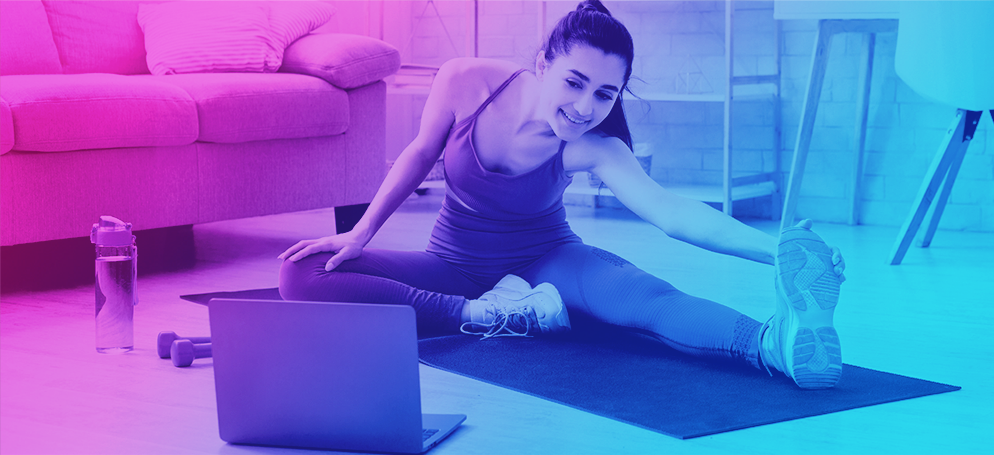
Life after Covid-19: The future of the fitness sector
This week, the Summer Olympics were supposed to kick off in Tokyo, Japan. However, because of Covid-19, they have been moved to 2021 – the first time the Olympic Games have ever been postponed. To mark the original date, we’re taking a look at what the future holds for the fitness industry in a post-Covid world.
The pandemic has raised awareness of fitness
One outcome of the crisis has been increased emphasis on the importance of fitness, with news and media offering near daily reminders in a way that was not seen pre-pandemic. Poor cardiovascular health is one of the major risk factors for severe illness or death as a result of Covid-19, and this has driven significant media coverage. Post-Covid, it is likely that governments around the world will encourage populations to exercise more as part of their efforts to improve public health.
Exercise equipment and apparel spiked during lockdowns
Global lockdowns led to gym closures and the cancellation of sporting events around the world. As a result, purchases of home fitness equipment from big-ticket items like treadmills to more basic items like dumbbells spiked, causing supply shortages as people tried to ensure they could maintain their usual fitness routines.
Along with a spike in fitness equipment, demand for fitness clothing increased, accelerating a trend towards loungewear or athleisure in recent years. (Some of this may have been driven by a desire to wear comfortable clothing at home, as much as a desire to work out.) For example:
- In the US, during lockdown, demand for certain fitness clothing was up 40% YoY and in the UK, as much as 97%
- In the UK, demand for sports shoes – sneakers – was up 23% YoY
Brands responded to the situation with changed messaging:
- Last year, Nike’s promotions centred around new season drops. This year, it challenged customers to be active from their living room with the Nike Training Club app, which it made free to everyone in the US earlier in the crisis
- Adidas enlisted athletes and creatives to share skills and advice with the #HOMETEAM community. It also offered three months’ full access to its training app with tailored plans and 230+ exercises
- Asics opened access to its Studio and Runkeeper app, with the message of ‘In times of uncertainty, movement helps’
- Gymshark rebranded as Homeshark during the pandemic, to reinforce the public health message of staying at home
The crisis has accelerated a shift to digital
Virtual fitness was already a trend before the crisis, with fitness brands investing heavily to integrate technology into the customer experience. The crisis has accelerated this – for example:
- Gold’s Gym made its app free to download and use and saw hundreds of thousands of downloads. The company accelerated improvements that had already been in the works and added new features
- Peloton – a virtual fitness company which sells subscriptions at different price points and already offered a blend of live or on-demand at-home workouts – has seen a significant bump since the pandemic began, pushing the company over the 1 million subscriber mark
- Fitternity, the largest online marketplace for fitness services in India, had almost 500,000 monthly active users who booked studio and gym classes via its app. Following lockdown, Fitternity pivoted to offer live online classes, recorded video sessions and one-on-one virtual coaching. It charges about 60% to 70% of the regular in-person fee for online workouts and has only seen about a 20% dip in active user numbers
- Those who work for large companies might also get a post-pandemic fitness boost. Fitternity has reported a 200% increase in corporate requests, as businesses look to offer staff working-from-home perks, a trend that US fitness booking app ClassPass has also noticed
Influencers are in a unique position
Lockdowns created a good opportunity for fitness influencers to create content for social channels and also partner with brands:
- Most famously in the UK, Joe Wicks, aka The Body Coach, held daily live PE sessions on YouTube for children who were out of school. The global awareness of his campaign led him to stream PE lessons to children in Australia and the US
- Ciara Madden of @ciaralondon collaborated with DJ Mercedes Benson to create personalised playlists for her IG Live
- Gymshark offered an hourly rate to personal trainers struggling for work to host online workouts
- IG Live content gave lots of influencers the opportunity to keep their current audience engaged and expand their reach
Increased engagement during lockdowns was a big benefit for influencers who rely on monetisation from social networks like YouTube and Instagram.
Gyms won’t be the same in the near-term
Research suggests that group fitness situations, with many people breathing heavily as they exercise, are especially risky for spreading disease – which presents a problem for gyms when they are allowed to re-open.
A big question is how many people will return to gyms, once they are allowed to reopen – especially amongst those who have invested in home exercise equipment such as treadmills, exercise bikes and dumbbells and have formed new exercise habits at home. A recent survey by RunRepeat of over 10,000 people suggested that over half of all gym members do not plan on going back to a gym when they reopen. Furthermore, over a third of gym members have either cancelled their gym membership or are considering cancelling it. However, attitudes change as the situation evolves, so any poll should only be treated as a snapshot of a particular moment.
In the near term, key changes or challenges for gyms include:
Maintaining social distancing
Equipment will need to be spaced out, users may only be allowed to use alternative cardio machines with those not in use taped off, plus plexiglass installed to divide the space up. Gyms or fitness instructors who can run groups classes outside – e.g. in a park – are likely to do so.
Enhanced cleaning protocols
More hand sanitisers will need to be available, with members encouraged to be more pro-active about wiping down surfaces before and after using machines, and modified gym schedules to allow more frequent deep cleaning of machines and facilities.
Improved air quality
Exercisers breath heavily and the droplets from their breath can linger in the air. A potential solution to this is improved ventilation systems to refresh air inside the gym with filtered air from outside. Some gyms have asked members to wear masks. Members are also encouraged not to grunt or shout (!) when lifting heavy weights, to minimise droplets from their mouths.
Temperature checks
For gym staff and clients upon arrival – for example, in Beijing, when gyms reopened after three months of lockdown, everyone who entered a gym was required to have their temperature checked at the door.
Arrive gym and pool ready
Gyms and pools are asking people to arrive already changed. Post-exercise, they would ideally like you to go home to shower and change clothes which may present a problem for those going straight on elsewhere and certainly presents a challenge for swimmers.
More use of digital
Many gyms are now doing their best to create opportunities for online customers where possible. For example, where fitness classes can’t take place outside, we may see instructors teach a handful of people in person, while simultaneously broadcasting that workout to people logged in online. Social media makes video streaming an easy option, with Joe Wicks being an example that many are trying to follow. London fitness company Frame recently asked its audience on Instagram what exercise classes they would like to be streamed, ahead of the gym’s launch of Frame Online. We can expect to see more live-streaming workouts, posting videos for on-demand consumption, and motivational online coaching in future.
Some people who transitioned to at-home workouts successfully during lockdown are likely to continue working out at home, at least some of the time. This is partly because it is convenient and partly because they have the equipment now.
However, over time, many people are likely to return to their gym. Gyms still offer things that people cannot always achieve at home – most obviously, easy access to a range of equipment and work-out space, but also the expert knowledge of trainers and instructors, and the community and motivational aspect of working out with other people at the same time.
Summary
- The pandemic has increased awareness of the importance of fitness for health and wellbeing – which bodes well for the industry’s prospects
- Sales of fitness equipment and clothing increased during lockdown – many people worked out at home for the first time
- The crisis has accelerated a shift to digital
- Gyms will need to make significant changes in the short term to accommodate the new rules, most obviously integrating digital into the customer experience
- Whilst some people may not return to gym in the short term, the situation is evolving and so too are customer attitudes
If you’re looking for an international growth agency to help ensure your brand is in peak condition, please get in touch.

Sarah Jennings | CEO
Oban International is the digital marketing agency specialising in international expansion. Our LIME (Local In-Market Expert) Network provides up to date cultural input and insights from over 80 markets around the world, helping clients realise the best marketing opportunities and avoid the costliest mistakes.